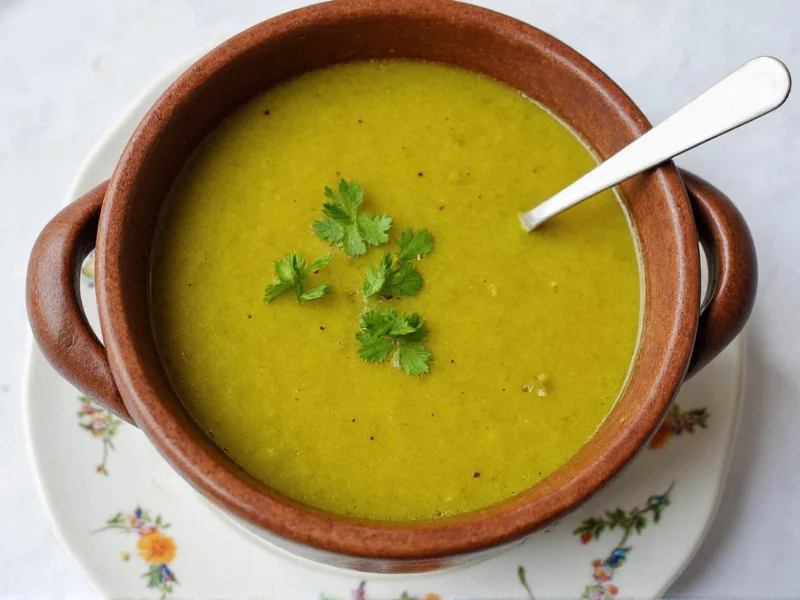When searching for “Andersen split pea soup,” many home cooks and soup enthusiasts encounter confusion. The reality is that “Andersen” isn't associated with any major commercial split pea soup brand. This common search query likely stems from either a misspelling of another name, confusion with a specific recipe creator, or misremembering a product label.
Understanding Split Pea Soup Basics
Split pea soup represents one of the world's oldest documented recipes, with origins tracing back to ancient civilizations. This hearty dish uses dried split peas—green or yellow peas that have been peeled and split along their natural seam. The “split” refers to the processing method, not the cooking technique.
Traditional split pea soup preparation involves simmering the peas with aromatics like onions, carrots, and celery, plus a protein element—typically ham hock, bacon, or smoked sausage. The magic happens as the peas break down during cooking, creating a naturally thick, creamy texture without dairy.
Common Commercial Brands of Split Pea Soup
While “Andersen split pea soup” doesn't exist as a commercial product, several established brands offer quality split pea soup options. Understanding these alternatives helps clarify the search confusion:
| Brand | Product Name | Key Features |
|---|---|---|
| Progresso | Hearty Split Pea with Ham | Creamy texture, visible ham pieces, no artificial flavors |
| Healthy Choice | Split Pea Soup | Lower sodium option, contains smoked ham |
| Imagine Foods | Organic Split Pea Soup | Certified organic ingredients, vegan option available |
| Home Food | Split Pea Soup | Traditional recipe, often found in Midwest grocery stores |
Authentic Homemade Split Pea Soup Recipe
Creating genuine split pea soup from scratch remains the best approach for superior flavor and texture. This traditional split pea soup recipe serves 6-8 and requires minimal specialized equipment:
Ingredients
- 2 cups dried green or yellow split peas, rinsed
- 1 meaty ham hock or 1 cup diced smoked ham
- 1 large onion, chopped
- 2 carrots, diced
- 2 celery stalks, diced
- 3 garlic cloves, minced
- 8 cups water or broth
- 2 bay leaves
- 1 teaspoon dried thyme
- Salt and pepper to taste
Preparation Steps
- Combine split peas, ham hock, onion, carrots, celery, garlic, water/broth, bay leaves, and thyme in a large pot
- Bring to a boil, then reduce heat to low and cover partially
- Simmer for 60-90 minutes until peas are completely broken down and soup has thickened
- Remove ham hock, shred any remaining meat, and return to soup
- Discard bay leaves and adjust seasoning
- For creamier texture, blend half the soup then return to pot
Perfecting Your Split Pea Soup Technique
Mastering easy split pea soup preparation requires understanding key technique elements. Many home cooks make split pea soup too thin or too thick by misunderstanding the natural thickening process. Unlike other soups requiring roux or cornstarch, split pea soup thickens organically as the peas disintegrate.
The ideal split pea soup consistency resembles a thick stew—coating the back of a spoon but still pourable. If your soup becomes too thick during cooking, simply add additional broth or water. Conversely, if too thin after full cooking time, continue simmering uncovered to reduce and concentrate flavors.
Nutritional Benefits of Split Pea Soup
Split pea soup nutritional benefits make it a powerhouse meal. One serving (about 1 cup) typically contains:
- Approximately 200-250 calories
- 15-18 grams of plant-based protein
- 10-12 grams of dietary fiber
- Rich in iron, potassium, and B vitamins
- Naturally low in fat (when prepared without excessive meat)
The combination of protein and fiber creates exceptional satiety, making split pea soup an excellent choice for weight management. The soluble fiber content also supports healthy cholesterol levels and digestive function.
Serving Suggestions and Pairings
Traditional split pea soup serving suggestions include crusty bread for dipping or a simple green salad for balance. For enhanced flavor, consider these pairings:
- Freshly baked sourdough or rye bread
- Sharp cheddar cheese biscuits
- Simple arugula salad with lemon vinaigrette
- Crusty baguette with garlic herb butter
For authentic European presentation, serve split pea soup in a hollowed bread bowl—particularly effective with sourdough or pumpernickel loaves. This traditional serving method adds both visual appeal and complementary flavor.
Storage and Reheating Guidelines
Understanding proper split pea soup storage tips ensures maximum freshness and safety. Cooked split pea soup maintains quality for:
- 3-4 days in airtight containers in the refrigerator
- Up to 6 months when properly frozen
When reheating, add small amounts of liquid as needed—the soup thickens significantly when chilled. For best results, thaw frozen soup overnight in the refrigerator before reheating. Never refreeze previously frozen soup.
Addressing Common Split Pea Soup Questions
Many home cooks encounter similar challenges when preparing split pea soup. Understanding these issues helps achieve perfect results every time:
- Why won't my split pea soup thicken? Ensure you're using dried split peas, not whole peas. The soup requires sufficient simmering time (60-90 minutes) for natural thickening.
- Can I make split pea soup without meat? Absolutely. Use smoked paprika or liquid smoke for depth, plus vegetable broth instead of meat-based stocks.
- How do I prevent split pea soup from becoming mushy? Avoid overcooking—once peas have broken down to desired consistency, remove from heat.











 浙公网安备
33010002000092号
浙公网安备
33010002000092号 浙B2-20120091-4
浙B2-20120091-4